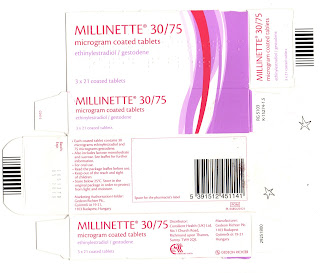The majority of the responses consisted of cigarette packets, but I did find some packaging for the contraceptive pill, antidepressants etc, which is a good place to start.
So what now?!
Make art from it of course! (when I'm not spending all of my time doing my essay)
Where to start? I've already looked at the use of children in anti-smoking campaigns, and how the aesthetic of the packaging is becoming standardised across all brands in the hope of discouraging the habit.
I decided to work from a different viewpoint by taking the contraceptive pill as a starting point to explore the ways that it is marketed and campaigned about:
- The contraceptive pill was introduced in the UK in 1961 for married women only. In 1967 it became available to all women, married or un married.
- In this mid-century period, women were expected to get married and start a family in their twenties; sex before marriage was heavily frowned upon
- In the US, birth control was illegal for married couples until 1965, and 1972 for single people
- During the great depression there was an array of absurdity into products that were used for contraception. For example, women used Lysol cleaning products to prevent pregnancy because it killed male sperm, but was also extremely dangerous to women health, in some cases resulting in death
- Adverts and campaigns for contraception are less mysoginistic and oppressive towards women today, thankfully. Many are lead by the NHS, FPA (family planning association) and condom brands such as durex.
- Some modern advertisements and campaigns take more of a 'tongue and cheek' approach to communicating with and informing audiences about safe sex, not forgetting some of the heavy text based 'straight to the point' ads produced on mass.
Heavily text based NHS ads, clever leaflet design though!
Humorous Durex Ads (condoms are cheaper than children)
How is this relevant?
Having just spieled off a number of different approaches to marketing contraceptives with visual imagery, if you're reading this you're probably wondering how this relates to my research question...?
The pill was first introduced in 1961, but was still exclusive to married women. In this time, women were very much still victim to oppression, having the blame placed on them if they became pregnant.
WHICH ISN'T OKAY!
The synthesis here, is that women may have perceived themselves to be doing something 'shameful', 'unfaithful', or 'inhumane' if they were to take the pill in the 60's/70's as a result of being victimised by the way that it was marketed. Women wouldn't have had a leg to stand on in that era if they were labelled as being non-conforming, therefore wouldn't have wanted to be associated with such brands of pills.
Today, marketing of contraceptives isn't as sexist and demeaning, and taking them is deemed as a responsible and safe action for women. BUT, I believe that this doesn't really reflect in its dull, clinical packaging. I'm aware that medical packaging does't always have a purpose to be beautifully crafted and designed by a graphic designer or illustrator, but what if it was?! People should't be ashamed to take medicine that has, or has in the past had a stigma attached to it;
I wonder how people would perceive themselves and others judging by the way that drugs are actually packaged?
When I think of a healthcare/cosmetic brand that glorifies femininity, I immediately think of 'Soap and Glory'.
- It has that 50's pin up girl, dainty charm-BUT WITHOUT BEING SEXIST
- Celebrates being a woman!!
- The packaging is hilarious, full of puns and euphemisms
I spent the afternoon trying to come up with some fun 'soap and glory-esk' names and packaging ideas for the contraceptive pill:
I actually had a really fun time doing these! I definitely want to have a go at doing some more designs and concepts around the theme of different medicines, and as well apply them to mockups of packaging and methods of advertising too. It will be interesting as well to maybe look more into how different people perceive themselves in relation to medication they take, and record it in a sort of social documentary style.
But now, back to essay writing! (send help)













No comments:
Post a Comment